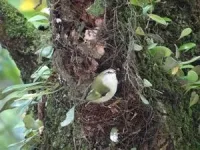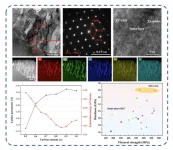(Press-News.org)
Parrots, songbirds, and hummingbirds can learn to make new sounds. No-one knew, but New Zealand’s smallest bird, the rifleman or titipounamu, may have a rudimentary version of the same talent.
University of Auckland research into the bird is part of a rethinking of how and when vocal learning evolved in birds.
Scientists traditionally assumed birds were split into two groups - those which can learn sounds (parrots, songbirds, and hummingbirds) and those which can’t - but the study published in the scientific journal Communications Biology adds to evidence challenging that assumption.
Vocal signatures of distantly related titipounamu had strong similarities if they lived near each other, the Waipapa Taumata Rau, University of Auckland research showed. Close relatives living far apart didn’t sound similar.
That suggests the birds’ sounds may not be innate and may be learned from each other, according to Dr Kristal Cain, the senior author of the study, and Dr Ines G. Moran, the lead author.
Weighing the same as five or six paper clips, titipounamu live in high-altitude mature native forest, feed on insects and make high-pitched sounds inaudible to some people.
The bird is one of the country’s two surviving native wren species and a sort of evolutionary missing link between two of the most impressive learners, songbirds and parrots. Relics of Gondwana, the wrens likely existed in Aotearoa since before the islands broke away from the super continent, roughly 80 million years ago.
“If New Zealand wrens are vocal learners, then it is likely that the common ancestor of parrots and songbirds was also capable of rudimentary learning,” says Cain. “This ability in birds could have evolved millions of years earlier than we previously thought.”
Vocal learning in songbirds evolved 30-50 million years ago, scientists have estimated. But the songbirds and parrots diverged long before that – closer to 80 million years ago.
Vocal convergence
The scientists went to all sorts of lengths to gather evidence of vocal copying, such as “vocal convergence,” where animals’ calls become acoustically similar.
First, they closely monitored the nests of titipounamu at Boundary Stream Mainland Island in the Hawke’s Bay, identifying and banding individuals and then recording more than 6,800 of the feeding calls routinely made by adult birds (parents and the parents’ helpers) bringing food to the young nestlings over three summers.
While the differences in the birds’ calls can’t be detected by most people, detailed analysis of spectrograms – “voiceprints” – revealed unique individual vocal signatures.
The researchers then acquired genetic information on the population at large.
Finally, they used advanced genetic methods to estimate how much and which aspects of the vocal signature came from genetics as opposed to the social environment. For some parameters, social environment was more important than genetics; there were similarities with a known vocal learner, the zebra finch.
The evidence from the scientists’ study isn’t conclusive but it’s strongly suggestive of “rudimentary vocal learning abilities.”
“A growing body of evidence suggests we may need to stop classifying birds as either vocal learners or vocal non-learners,” says Cain. “The ability may be much more widespread and likely exists along a spectrum.”
Humans, whales, bats
Most animals communicate with unlearned, innate vocalisations, while vocal learners include humans, whales and dolphins, elephants and bats.
“The vocal behaviour that we were unravelling in this study is very similar to what is known as vocal accommodation in human linguistics,” says Moran. “It’s similar to our ability to adjust our ways of speaking in different social, dialectic, or hierarchical settings – modulating our voices to better fit in certain social groups.”
Artificial intelligence, custom engineered nest RFID (radio frequency identification) readers, and custom-made computer analysis tools were all part of the study, which spanned bioacoustics, genetics, behavioural ecology, and field biology.
The scientists thanked the mana whenua of the Maungaharuru region, the University’s engineering team, the Department of Conservation, AgResearch, and the Centre for eResearch.
A Royal Society Te Apārangi Marsden Fund grant supported the research and funding also came from the University of Auckland Doctoral Scholarship and Press Account, Birds New Zealand Research Funds, and the Centre for Biodiversity and Biosecurity.
Learn more about the use of animals in research and teaching at the University of Auckland.
Media contact
Paul Panckhurst | media adviser
M: 022 032 8475
E: paul.panckhurst@auckland.ac.nz
END
Tiny New Zealand bird delivers a lesson in birdsong evolution
Scientists are rethinking how and when vocal learning evolved in birds
2024-06-14
ELSE PRESS RELEASES FROM THIS DATE:
The phase transition of multi-component (TiZrVNb)C ceramics
2024-06-14
In recent years, high-entropy carbide ceramics have received extensive attention and become another research focus in the high entropy materials field, which are also known as multi-component carbide ceramics. The multi-component carbide ceramics not only inherit the special properties of high-entropy materials brought by complex compositions, but also keep the advantages of transition metal carbide ceramics as a kind of ultra-high temperature ceramics (UHTCs), such as high melting point, high-temperature stability, high Young's modulus, high hardness, and ...
Does endogenous technological change matter in model-based climate change narratives?
2024-06-14
Curbing the confirmed human influence on the climate system and mitigating climate change require profound transformation of global energy system. In this context, modeling technical progress and innovation within Integrated Assessment Models (IAMs) is crucial for providing insights about the consequences of long-term energy system transformation, and capturing the development of several interacting systems and technical evolution process.
A review of Endogenous Technological Change (ETC) written by Hongbo Duan ...
Bringing data to life: New interactive dashboard provides analysis and visualization of sickle cell disease prevalence and burden in an entire state
2024-06-14
INDIANAPOLIS – The Indiana Sickle Cell Dashboard, launching this month on the Regenstrief Institute website, presents a dynamic, panoptic picture of sickle cell disease throughout an entire state. The new dashboard uses de-identified data from throughout the state of Indiana, obtained from multiple clinical and administrative sources, to present easy-to-understand, interactive visualizations of the disease’s prevalence and burden.
The pioneering dashboard, created, developed and maintained by the Regenstrief Institute, is one of the first ...
Synthetic data holds the key to determining best statewide transit investments, new NYU Tandon School of Engineering study finds
2024-06-14
Synthetically generated population data can reveal the equity impacts of distributing transportation resources and funding across diverse regions, according to new research from NYU's Tandon School of Engineering that uses New York State as a case study.
Relying on an artificial dataset representing 19.5 million New York residents and over 120,000 modeled origin-destination trips, researchers from NYU Tandon's C2SMARTER, a Tier 1 U.S U.S. Department of Transportation-funded University Transportation Center, determined how best to invest in transportation services when equitable benefits are an objective.
They ...
New research finds biases encoded in language across cultures and history
2024-06-14
In a new study, published in Social Psychological and Personality Science, researchers share evidence that people’s attitudes are deeply woven into language and culture across the globe and centuries.
The researchers looked at connections between people’s attitudes and language from 55 different topics like rich vs. poor, dogs vs. cats, or love vs. money. They used four text sources: Current English writing and text, English books going back 200 years, and texts in 53 languages other than English. As a measure of people’s attitudes, they used data from over 100,000 Americans; first, direct self-reports, and second, an indirect ...
Mothers lower risk of caesarean births after COVID vaccination
2024-06-14
Pregnant women who have been vaccinated against Covid-19 are less likely to have a caesarean section or experience hypertension, according to a study.
A meta-analysis funded by the National Institute for Health and Care Research Birmingham Biomedical Research Centre of 67 studies which included more than 1.8m women found that being fully vaccinated against COVID-19 had a protective benefit against infection and hospitalisation, while vaccination with at least one dose lowered the risk of adverse pregnancy-related and neonatal outcomes.
Drawing on ...
Ultrasensitive liquid biopsy tech spots cancer earlier than standard methods
2024-06-14
An artificial intelligence-powered method for detecting tumor DNA in blood has shown unprecedented sensitivity in predicting cancer recurrence, in a study led by researchers at Weill Cornell Medicine, NewYork-Presbyterian, the New York Genome Center (NYGC) and Memorial Sloan Kettering Cancer Center (MSK). The new technology has the potential to improve cancer care with the very early detection of recurrence and close monitoring of tumor response during therapy.
In the study, which appears June 14 in Nature Medicine, the researchers showed that they could train a machine learning model, a type ...
New study emphasizes tradeoffs between arresting groundwater depletion and food security
2024-06-14
Washington DC, June 14, 2024: A study by authors from the International Food Policy Research Institute (IFPRI), published today in Nature Sustainability, reaffirms the world’s growing dependence on depleting groundwater systems. Although efforts to slow down groundwater depletion need to be urgently accelerated, this study indicates that such efforts – in the absence of other accompanying measures – would likely lead to significant food security impacts. The study finds that ending groundwater depletion would lead to sharp declines in food production, ...
Germline CDH1 variants and lifetime cancer risk
2024-06-14
About The Study: Among families from North America with germline CDH1 P/LP variants, the cumulative risk of gastric cancer was 7% to 10%, which was lower than previously described, and the cumulative risk of breast cancer among female carriers was 37%, which was similar to prior estimates. These findings inform current management of individuals with germline CDH1 variants.
Quote from corresponding author Jeremy L. Davis, M.D.:
“We showed that the lifetime risk of cancer, specifically stomach cancer, in people born with CDH1 gene mutations is lower ...
Dapagliflozin for critically ill patients with acute organ dysfunction
2024-06-14
About The Study: The addition of dapagliflozin, a sodium-glucose cotransporter 2 inhibitor, to standard care for critically ill patients and acute organ dysfunction did not improve clinical outcomes; however, confidence intervals were wide and could not exclude relevant benefits or harms for dapagliflozin.
Corresponding Author: To contact the corresponding author, Fernando G. Zampieri, M.D., Ph.D., email fernando.zampieri@einstein.br.
To access the embargoed study: Visit our For The Media website at this link https://media.jamanetwork.com/
(doi:10.1001/jama.2024.10510)
Editor’s ...
LAST 30 PRESS RELEASES:
Heart-brain connection: international study reveals the role of the vagus nerve in keeping the heart young
Researchers identify Rb1 as a predictive biomarker for a new therapeutic strategy in some breast cancers
Survey reveals ethical gaps slowing AI adoption in pediatric surgery
Stimulant ADHD medications work differently than thought
AI overestimates how smart people are, according to HSE economists
HSE researchers create genome-wide map of quadruplexes
Scientists boost cell "powerhouses" to burn more calories
Automatic label checking: The missing step in making reliable medical AI
Low daily alcohol intake linked to 50% heightened mouth cancer risk in India
American Meteorological Society announces Rick Spinrad as 2026 President-Elect
Biomass-based carbon capture spotlighted in newly released global climate webinar recording
Illuminating invisible nano pollutants: advanced bioimaging tracks the full journey of emerging nanoscale contaminants in living systems
How does age affect recovery from spinal cord injury?
Novel AI tool offers prognosis for patients with head and neck cancer
Fathers’ microplastic exposure tied to their children’s metabolic problems
Research validates laboratory model for studying high-grade serous ovarian cancer
SIR 2026 delivers transformative breakthroughs in minimally invasive medicine to improve patient care
Stem Cell Reports most downloaded papers of 2025 highlight the breadth and impact of stem cell research
Oxford-led study estimates NHS spends around 3% of its primary and secondary care budget on the health impacts of heat and cold in England
A researcher’s long quest leads to a smart composite breakthrough
Urban wild bees act as “microbial sensors” of city health.
New study finds where you live affects recovery after a hip fracture
Forecasting the impact of fully automated vehicle adoption on US road traffic injuries
Alcohol-related hospitalizations from 2016 to 2022
Semaglutide and hospitalizations in patients with obesity and established cardiovascular disease
Researchers ‘listen in’ to embryo-mother interactions during implantation using a culture system replicating the womb lining
How changing your diet could help save the world
How to make AI truly scalable and reliable for real-time traffic assignment?
Beyond fragmented markets: A new framework for efficient and stable ride-pooling
Can shape priors make road perception more reliable for autonomous driving?
[Press-News.org] Tiny New Zealand bird delivers a lesson in birdsong evolutionScientists are rethinking how and when vocal learning evolved in birds



